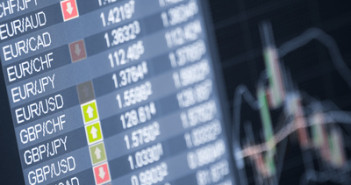Foreign exchange markets are a mixed bag one day after the most recent Federal Reserve meeting. Central banks in Japan and New Zealand also convened to little fanfare but it was FOMC that garnered much of the headlines, as usual. The Federal Open Market Committee (FOMC) kept rates unchanged at 0.25% on the same day it was revealed the US economy only grew at an annual pace of 0.2%. Wall Street analysts were expecting growth closer to 1.0% and as a result the US dollar continues its slide lower twenty fours later. Economic data in Europe and Asia was muted as global equities are a sea of red, seemingly very concerned over global growth prospects. The euro is Thursday’s winner, trading more than 1.2% above the overnight low.
As for yesterday’s FOMC meeting, the immediate reaction was a stronger dollar. As expected, the Fed kept rates unchanged at 0.25% and despite shaky Q1 growth – as divulged yesterday – the Committee noted some progress in the economy. The statement acknowledged that growth had slowed during the winter months, but called the factors leading this slowdown “transitory.†Inflation and employment expectations remain balanced for the duration of 2015. Perhaps the most interesting take-away was the Committee removed any hints of what lies ahead by eliminating any calendar references. Following its March meeting, the Fed noted a rate hike in April was unlikely, now the market seems to be pointing toward a September hike – but this is purely speculation. Like central banks in Japan and New Zealand, which also kept policies unchanged, it was a fairly muted reaction. Yesterday’s Q1 GDP report really stole the spotlight and continues to have the biggest impact on Thursday as the greenback is broadly lower.
The euro is alternatively finding a boost amid reports that Greece’s government has offered its biggest concessions to date in a race to come to an agreement with lenders. The euro is now 7% above its lowest point as Greek leaders continue to bend and break in negotiations with European and IMF lenders, trying their best to avoid national bankruptcy. Following last week’s “deadlineâ€, both sides are working toward a new May 12th deadline as Athens needs fresh aid before a 750 million euro payment is to be made to the IMF. Spanish GDP figures overnight surprised on the topside along with April inflation. As QE filters through mainland Europe, recent data has supported that European officials have done a good job to thwart deflation in 2015, ending a four month streak of declines in consumer prices.
This morning, the US released weekly jobless claims and it was reported that only 262k Americans filed for unemployment claims for the first time. This is the first number to beat expectations in some time, which has created some doubt for investors in what was the only outperforming sector of the US economy – labor. Despite these stronger than expected numbers, the dollar is finding a tough time breaking higher out this most recent tailspin. Looking to the north, Canadian February GDP
also came in a touch better than expectations at 0.0% growth. The Canadian dollar, which has been moving higher for the last few weeks as oil and commodity prices have both stabilized, is finding a base at current levels, nearly 6.5% above its low from March. The “Loonie†could be approaching overbought status now and a correction is most like to be expected over the next few days. Bank of Chairman Poloz speaks at 10:30am EST.
Tomorrow is May Day so most of mainland Europe has the day off. To close out the data week, China and the US will both release Manufacturing and Non-Manufacturing  PMIs for the month of April. Have a great rest of the week.
Further reading:
Japan
Canadian February GDP



